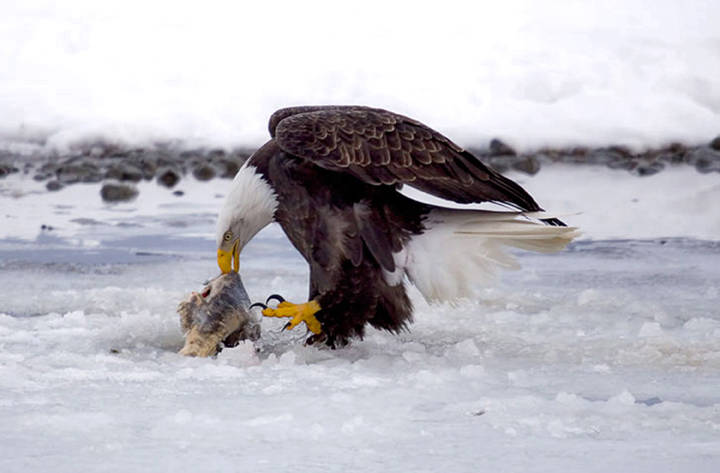The tribal government of Klukwan filed a lawsuit Monday against the Bureau of Land Management, accusing it of failing to protect culturally-important salmon habitat and world’s largest bald eagle congregation from mining on the Chilkat River drainage.
Filed in U.S. District Court on Monday, the suit alleges that BLM neglected its duties when permitting expansions of mineral exploration in the area in the last year and a half.
Permitting mineral exploration would eventually lead to the creation of a hard rock mine, the suit argues, which has been shown to negatively affect water bodies downstream. Mining companies conduct mineral exploration in hopes of documenting the existence of valuable ore bodies. Smaller exploration companies often then sell their claims to larger extraction companies after they’ve proved valuable.
BLM is required to consider the environmental impact of a future mine when permitting exploration, Klukwan argues, not just the impact of exploration itself.
“Over the past several years our Tribe has been having government-to-government discussions with BLM regarding the permitting process for mining in the Chilkat Watershed,” said Kimberley Strong, Tribal President of the Chilkat Indian Village of Klukwan. “We have strongly objected to BLM’s permitting process as it does not take into account the environmental risks from a fully operating hard rock mine.”
North of Haines, Alaska, the Chilkat River is home to five species of Pacific salmon and the Alaska Chilkat Bald Eagle Preserve. The Tlingit people of Klukwan have depended on the river for thousands of years. The mine claim in dispute lies about 16 miles upriver from the village.
The legal nonprofit Earthjustice is representing Klukwan and conservation groups Southeast Alaska Conservation Council, Lynn Canal Conservation and Rivers Without Borders in the suit.
Under the Environmental Policy Act, BLM must not only consider the effects of mineral exploration but of the potential harm any subsequent mining in the area would cause, Earthjustice attorney Kenta Tsuda explained in a Monday phone interview.
“BLM is committing itself to a path while willfully ignorant of the destination,” Tsuda said. “We’re asking the court to make the agency take off the blindfold and evaluate the impacts of its decisions before it’s too late.”
A project lead for BLM didn’t pick up their phone Monday afternoon.
The claim centers around the Palmer Project, a mid-stage drilling program that could pave the way for a large-scale underground copper-zinc-gold-silver mine in the Chilkat River Valley. Canadian company Constantine Metal Resources LLC operates the project and did not immediately return phone requests for an interview Monday.
The Palmer Project’s development began in 2008 when BLM approved Constantine to carry out ground disturbance on 5 acres of land when drilling for mineral exploration. BLM approved an expansion of exploratory drilling in August 2016, allowing Constantine to create 2.5 miles of additional road, adding access to up to 40 more drill sites. Further changes to drilling permits were approved in September 2017. Earthjustice disputes both the August 2016 expansion and the September 2017 changes.
The Palmer Project lies on a mountainside above Glacier Creek, a tributary of the Klehini River which flows into the Chilkat River. Constantine plans to continue in the exploration phase of their project for the next 5-10 years.
The Chilkat River runs from its headwaters in the Coast Mountains of British Columbia, Canada, into the sea near Haines. It is known as “Jilkaat Heeni” in the Tlingit language, meaning “storage container for salmon.”
Five species of Pacific salmon spawn on the river and are targetted by commercial, subsistence and sport fishers. A warm-water natural phenomenon keeps a 5-mile stretch of the Chilkat free of ice into late fall and winter, allowing the world’s largest concentration of bald eagles to feed on late-spawning salmon and marine life well into the winter.
In 1982, the state of Alaska designated 48,000 acres of river bottom on the Chilkat and its tributaries as the Alaska Chilkat Bald Eagle Preserve. Preservation status adds stiffer regulation to firearm use, guiding, hunting and aircraft activity in the area, which is managed by the state of Alaska Parks and Outdoor Recreation. As many as 3,000 bald eagles have been spotted in area at one time. The Palmer Project lies about eight miles from an arm of the Klehini River boundary of the preserve.
Correction: This article originally appeared with a misspelling of an Earthjustice attorney’s name. Kenta Tsuda’s first name is spelled Kenta, not Ketna, as originally reported.
• Contact reporter Kevin Gullufsen at 523-2228, kevin.gullufsen@juneauempire.com or through his Twitter handle @KevinGullufsen.

